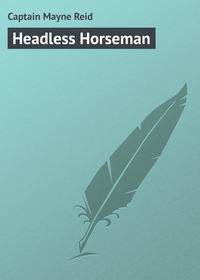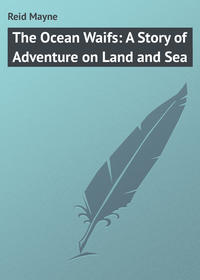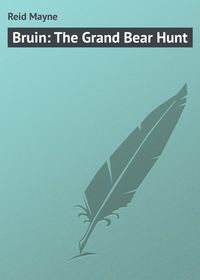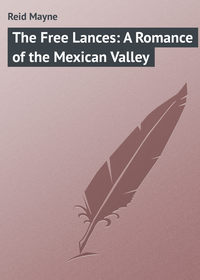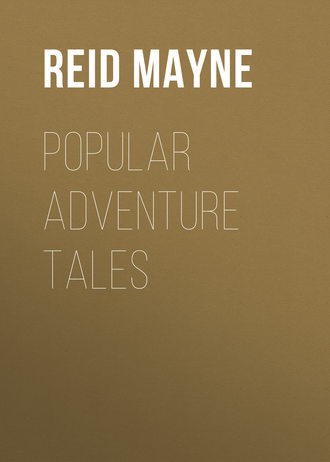 полная версия
полная версияPopular Adventure Tales

Mayne Reid
Popular Adventure Tales
BIOGRAPHICAL SKETCH
Captain Mayne Reid was born at Ballyroney, County Down, on the 4th April, 1818, and was the son of the Rev. Thomas Mayne Reid. Mayne Reid was educated with a view to the Church, but finding his inclinations opposed to this calling, he emigrated to America and arrived in New Orleans on January, 1840. After a varied career as plantation over-seer, school-master, and actor, with a number of expeditions in connection with hunting and Indian warfare, he settled down in 1843 as a journalist in Philadelphia, where he made the acquaintance of Edgar Allan Poe.
Leaving Philadelphia in 1846, he spent the summer at Newport, Rhode Island, as the correspondent of the New York Herald, and in December of the same year, having obtained a commission as second lieutenant in the 1st New York Volunteers, he sailed for Vera Cruz to take part in the Mexican war. He behaved with conspicuous gallantry in many engagements, and was severely wounded and disabled at the storming of Chapultepec on the 13th September, 1847.
Returning to the United States in the spring of 1848, he resumed literary work. But in June, 1849, he sailed for Europe in order to take part in the revolutionary movements going on in Hungary and Bavaria, arriving however too late, he turned his attention again to literature, and in London in 1850, published his first novel “The Rifle Rangers,” in two volumes. Between this date and his death, he produced a large number of volumes, which indeed no one else was capable of writing, for in them are avowedly embodied the observations and experiences of his own extraordinary career.
Unfortunate building and journalistic speculation and enterprises involved him in financial failure, so he returned to New York in October, 1867. There he founded and conducted The Onward Magazine, but owing to recurring bad effects of his old Mexican wound, he had to abandon work for sometime and go into the hospital, on leaving which he returned to England in 1870. During the later years of his life he resided at Ross in Herefordshire where he died on the 22nd October, 1883, and was buried in Kensal Green Cemetery.
Mayne Reid wrote in all thirty-five works, chiefly books of adventure and travel. As in the case of all authors, the books vary much in merit, but most of them are of a high order in their own department of literature. Many of them have been extraordinary popular and have become standard works. Reid has not been surpassed by any other writer in combining at one and the same time, the features of thrilling adventure and great instruction in the fields of natural history. Many of the works have been translated into Continental languages and are as highly esteemed among the French and Germans as at home.
Popular Adventure Tales
CHAPTER I
THE FUR COUNTRIES
Boy reader, you have heard of the Hudson's Bay Company? Ten to one you have worn a piece of fur which it has provided for you; if not, your pretty little sister has – in her muff, or her boa, or as a trimming for her winter dress. Would you like to know something of the country whence come these furs? – of the animals whose backs have been stripped to obtain them? As I feel certain that you and I are old friends, I make bold to answer for you – yes. Come, then! let us journey together to the “Fur Countries;” let us cross them from south to north.
A vast journey it will be. It will cost us many thousand miles of travel. We shall find neither railway-train, nor steamboat, nor stagecoach, to carry us on our way. We shall not even have the help of a horse. For us no hotel shall spread its luxurious board; no road-side inn shall hang out its inviting sign and “clean beds;” no roof of any kind shall offer us its hospitable shelter. Our table shall be a rock, a log, or the earth itself; our lodging a tent; and our bed the skin of a wild beast. Such are the best accommodations we can expect upon our journey. Are you still ready to undertake it? Does the prospect not deter you?
No – I hear you exclaim – I shall be satisfied with the table – what care I for mahogany? With the lodging – I can tent like an Arab. With the bed – fling feathers to the wind!
Enough, brave boy! you shall go with me to the wild regions of the “North-west,” to the far “fur countries” of America. But, first – a word about the land through which we are going to travel.
Take down your atlas. Bend your eye upon the map of North America. Note two large islands – one upon the right side, Newfoundland; another upon the left, Vancouver. Draw a line from one to the other; it will nearly bisect the continent. North of that line you behold a vast territory. How vast? You may take your scissors, and clip fifty Englands out of it! There are lakes there in which you might drown England, or make an island of it! Now, you may form some idea of the vastness of that region known as the “fur countries.”
Will you believe me, when I tell you that all this immense tract is a wilderness – a howling wilderness, if you like a poetical name? It is even so. From north to south, from ocean to ocean – throughout all that vast domain, there is neither town nor village – hardly anything that can be dignified with the name of “settlement.” The only signs of civilisation to be seen are the “forts,” or trading posts of the Hudson's Bay Company; and these “signs” are few and far – hundreds of miles – between.
For inhabitants, the country has less than ten thousand white men, the employés of the Company; and its native people are Indians of many tribes, living far apart, few in numbers, subsisting by the chase, and half starving for at least a third part of every year! In truth, the territory can hardly be called “inhabited.” There is not a man to every ten miles; and in many parts of it you may travel hundreds of miles without seeing a face, red, white, or black!
The physical aspect is, therefore, entirely wild. It is very different in different parts of the territory. One tract is peculiar. It has been long known as the “Barren Grounds.” It is a tract of vast extent. It lies north-west from the shores of Hudson's Bay, extending nearly to the Mackenzie River. Its rocks are primitive. It is a land of hills and valleys – of deep dark lakes and sharp-running streams. It is a woodless region. No timber is found there that deserves the name. No trees but glandular dwarf birches, willows, and black spruce, small and stunted. Even these only grow in isolated valleys. More generally the surface is covered with coarse sand – the debris of granite or quartz-rock – upon which no vegetable, save the lichen or the moss, can find life and nourishment.
In one respect these “Barren Grounds” are unlike the deserts of Africa: they are well watered. In almost every valley there is a lake; and though many of these are land-locked, yet do they contain fish of several species. Sometimes these lakes communicate with each other by means of rapid and turbulent streams passing through narrow gorges; and lines of those connected lakes form the great rivers of the district.
Such is a large portion of the Hudson's Bay territory. Most of the extensive peninsula of Labrador partakes of a similar character; and there are other like tracts west of the Rocky Mountain range in the “Russian possessions.”
Yet these “Barren Grounds” have their denizens. Nature has formed animals that delight to dwell there, and that are never found in more fertile regions. Two ruminating creatures find sustenance upon the mosses and lichens that cover their cold rocks: they are the caribou (reindeer) and the musk-ox. These, in their turn, become the food and subsistence of preying creatures. The wolf, in all its varieties of grey, black, white, pied, and dusky, follows upon their trail. The “brown bear” – a large species, nearly resembling the “grizzly” – is found only in the Barren Grounds; and the great “Polar bear” comes within their borders, but the latter is a dweller upon their shores alone, and finds his food among the finny tribes of the seas that surround them. In marshy ponds, existing here and there, the musk-rat builds his house, like that of his larger cousin, the beaver. Upon the water sedge he finds subsistence; but his natural enemy, the wolverene, skulks in the same neighbourhood.
The “Polar hare” lives upon the leaves and twigs of the dwarf birch-tree; and this, transformed into its own white flesh, becomes the food of the Arctic fox. The herbage, sparse though it be, does not grow in vain. The seeds fall to the earth, but they are not suffered to decay. They are gathered by the little lemmings and meadow-mice, who, in their turn, become the prey of two species of mustelidæ, the ermine and vison weasels. Have the fish of the lakes no enemy? Yes – a terrible one in the Canada otter. The mink-weasel, too, pursues them; and in summer, the osprey, the great pelican, the cormorant, and the white-headed eagle.
These are the fauna of the Barren Grounds. Man rarely ventures within their boundaries. The wretched creatures who find a living there are the Esquimaux on their coasts, and a few Chippewa Indians in the interior, who hunt the caribou, and are known as “caribou-eaters.” Other Indians enter them only in summer, in search of game, or journeying from point to point; and so perilous are these journeyings, that numbers frequently perish by the way. There are no white men in the Barren Grounds. The “Company” has no commerce there. No fort is established in them: so scarce are the fur-bearing animals of these parts, their skins would not repay the expense of a “trading post.”
Far different are the “wooded tracts” of the fur countries. These lie mostly in the southern and central regions of the Hudson's Bay territory. There are found the valuable beaver and the wolverene that preys upon it. There dwells the American hare with its enemy the Canada lynx. There are the squirrels, and the beautiful martens (sables) that hunt them from tree to tree. There are found the foxes of every variety, the red, the cross, and the rare and highly-prized silver-fox, whose shining skin sells for its weight in gold! There, too, the black bear yields its fine coat to adorn the winter carriage, the holsters of the dragoon, and the shako of the grenadier. There the fur-bearing animals exist in greatest plenty, and many others whose skins are valuable in commerce, as the moose, the wapiti, and the wood-bison.
But there is also a “prairie” district in the fur countries. The great table prairies of North America, that slope eastward from the Rocky Mountains, also extend northward into the Hudson's Bay territory. They gradually grow narrower, however, as you proceed farther north, until, on reaching the latitude of the Great Slave Lake, they end altogether. This “prairie-land” has its peculiar animals. Upon it roams the buffalo, the prong-horned antelope, and the mule-deer. There, too, may be seen the “barking wolf” and the “swift fox.” It is the favourite home of the marmots, and the gauffres or sand-rats; and there, too, the noblest of animals, the horse, runs wild.
West of this prairie tract is a region of far different aspect – the region of the Rocky Mountains. This stupendous chain, sometimes called the Andes of North America, continues throughout the fur countries from their southern limits to the shores of the Arctic Sea. Some of its peaks overlook the waters of that sea itself, towering up near the coast. Many of these, even in southern latitudes, carry the “eternal snow.” This “mountain-chain” is, in places, of great breadth. Deep valleys lie in its embrace, many of which have never been visited by man. Some are desolate and dreary; others are oäses of vegetation, which fascinate the traveller whose fortune it has been, after toiling among naked rocks, to gaze upon their smiling fertility.
These lovely wilds are the favourite home of many strange animals. The argali, or mountain-sheep, with his huge curving horns, is seen there; and the shaggy wild goat bounds along the steepest cliffs. The black bear wanders through the wooded ravines; and his fiercer congener, the “grizzly” – the most dreaded of all American animals – drags his huge body along the rocky declivities.
Having crossed the mountains, the fur countries extend westward to the Pacific. There you encounter barren plains, treeless and waterless; rapid rivers, that foam through deep, rock-bound channels; and a country altogether rougher in aspect, and more mountainous, than that lying to the east of the great chain. A warmer atmosphere prevails as you approach the Pacific, and in some places forests of tall trees cover the earth. In these are found most of the fur-bearing animals; and, on account of the greater warmth of the climate, the true felidæ– the long-tailed cats – here wander much farther north than upon the eastern side of the continent. Even so far north as the forests of Oregon these appear in the forms of the cougar and the ounce.
But it is not our intention at present to cross the Rocky Mountains. Our journey will lie altogether on the eastern side of that great chain. It will extend from the frontiers of civilization to the shores of the Arctic Sea. It is a long and perilous journey, boy reader; but as we have made up our minds to it, let us waste no more time in talking, but set forth at once. You are ready? Hurrah!
CHAPTER II
THE YOUNG VOYAGEURS
There is a canoe upon the waters of Red River – Red River of the north. It is near the source of the stream, but passing downward. It is a small canoe, a frail structure of birch-bark, and contains only four persons. They are all young – the eldest of them evidently not over nineteen years of age, and the youngest about fifteen.
The eldest is nearly full-grown, though his body and limbs have not yet assumed the muscular development of manhood. His complexion is dark, nearly olive. His hair is jet black, straight as an Indian's, and long. His eyes are large and brilliant, and his features prominent. His countenance expresses courage, and his well-set jaws betoken firmness and resolution. He does not belie his looks, for he possesses these qualifications in a high degree. There is a gravity in his manner, somewhat rare in one so young; yet it is not the result of a morose disposition, but a subdued temperament produced by modesty, good sense, and much experience. Neither has it the air of stupidity. No: you could easily tell that the mind of this youth, if once roused, would exhibit both energy and alertness. His quiet manner has a far different expression. It is an air of coolness and confidence, which tells you he has met with dangers in the past, and would not fear to encounter them again.
It is an expression peculiar, I think, to the hunters of the “Far West,” – those men who dwell amidst dangers in the wild regions of the great prairies. Their solitary mode of life begets this expression. They are often for months without the company of a creature with whom they may converse – months without beholding a human face. They live alone with Nature, surrounded by her majestic forms. These awe them into habits of silence. Such was in point of fact the case with the youth whom we have been describing. He had hunted much, though not as a professional hunter. With him the chase had been followed merely as a pastime; but its pursuit had brought him into situations of peril, and in contact with Nature in her wild solitudes. Young as he was, he had journeyed over the grand prairies, and through the pathless forests of the West. He had slain the bear and the buffalo, the wild cat and the cougar. These experiences had made their impression upon his mind, and stamped his countenance with that air of gravity we have noticed.
The second of the youths whom we shall describe is very different in appearance. He is of blonde complexion, rather pale, with fair silken hair that waves gently down his cheeks, and falls upon his shoulders. He is far from robust. On the contrary, his form is thin and delicate. It is not the delicacy of feebleness or ill-health, but only a body of slighter build. The manner in which he handles his oar shows that he possesses both health and strength, though neither in such a high degree as the dark youth. His face expresses, perhaps, a larger amount of intellect, and it is a countenance that would strike you as more open and communicative. The eye is blue and mild, and the brow is marked by the paleness of study and habits of continued thought. These indications are no more than just, for the fair-haired youth is a student, and one of no ordinary attainments. Although only seventeen years of age, he is already well versed in the natural sciences; and many a graduate of Oxford or Cambridge would but ill compare with him. The former might excel in the knowledge – if we can dignify it by that name – of the laws of scansion, or in the composition of Greek idylls; but in all that constitutes real knowledge he would prove but an idle theorist, a dreamy imbecile, alongside our practical young scholar of the West.
The third and youngest of the party – taking them as they sit from stem to bow – differs in many respects from both those described. He has neither the gravity of the first, nor yet the intellectuality of the second. His face is round, and full, and ruddy. It is bright and smiling in its expression. His eye dances merrily in his head, and its glance falls upon everything. His lips are hardly ever at rest. They are either engaged in making words – for he talks almost incessantly – or else contracting and expanding with smiles and joyous laughter. His cap is jauntily set, and his fine brown curls, hanging against the rich roseate skin of his cheeks, give to his countenance an expression of extreme health and boyish beauty. His merry laugh and free air tell you he is not the boy for books. He is not much of a hunter either. In fact, he is not particularly given to anything – one of those easy natures who take the world as it comes, look upon the bright side of everything, without getting sufficiently interested to excel in anything.
These three youths were dressed nearly alike. The eldest wore the costume, as near as may be, of a backwoods hunter – a tunic-like hunting-shirt, of dressed buckskin, leggings and mocassins of the same material, and all – shirt, leggings, and mocassins – handsomely braided and embroidered with stained quills of the porcupine. The cape of the shirt was tastefully fringed, and so was the skirt as well as the seams of the mocassins. On his head was a hairy cap of raccoon skin, and the tail of the animal, with its dark transverse bars, hung down behind like the drooping plume of a helmet. Around his shoulders were two leathern belts that crossed each other upon his breast. One of these slung a bullet-pouch covered with a violet-green skin that glittered splendidly in the sun. It was from the head of the “wood-duck” the most beautiful bird of its tribe. By the other strap was suspended a large crescent-shaped horn taken from the head of an Opelousas bull, and carved with various ornamental devices. Other smaller implements hung from the belts, attached by leathern thongs: there was a picker, a wiper, and a steel for striking fire with. A third belt – a broad stout one of alligator leather – encircled the youth's waist. To this was fastened a holster, and the shining butt of a pistol could be seen protruding out; a hunting-knife of the kind denominated “bowie” hanging over the left hip, completed his “arms and accoutrements.”
The second of the youths was dressed, as already stated, in a somewhat similar manner, though his accoutrements were not of so warlike a character. Like the other, he had a powder-horn and pouch, but instead of knife and pistol, a canvass bag or haversack hung from his shoulder; and had you looked into it, you would have seen that it was half filled with shells, pieces of rock, and rare plants, gathered during the day – the diurnal storehouse of the geologist, the palæontologist, and botanist – to be emptied for study and examination by the night camp-fire. Instead of the 'coon-skin cap he wore a white felt hat with broad leaf; and for leggings and mocassins he had trousers of blue cottonade and laced buskins of tanned leather.
The youngest of the three was dressed and accoutred much like the eldest, except that his cap was of blue cloth – somewhat after the fashion of the military forage cap. All three wore shirts of coloured cotton, the best for journeying in these uninhabited regions, where soap is scarce, and a laundress not to be had at any price.
Though very unlike one another, these three youths were brothers. I knew them well. I had seen them before – about two years before – and though each had grown several inches taller since that time, I had no difficulty in recognising them. Even though they were now two thousand miles from where I had formerly encountered them, I could not be mistaken as to their identity. Beyond a doubt they were the same brave young adventurers whom I had met in the swamps of Louisiana, and whose exploits I had witnessed upon the prairies of Texas. They were the “Boy Hunters,” – Basil, Lucien, François! I was right glad to renew acquaintance with them. Boy reader, do you share my joy?
But whither go they now? They are full two thousand miles from their home in Louisiana. The Red River upon which their canoe floats is not that Red River, whose blood-like waters sweep through the swamps of the hot South – the home of the alligator and the gar. No, it is a stream of a far different character, though also one of great magnitude. Upon the banks of the former ripens the rice-plant, and the sugar-cane waves its golden tassels high in the air. There, too, flourishes the giant reed, the fan-palm, and the broad-leafed magnolia, with its huge snow-white flowers. There the aspect is Southern, and the heat tropical for most part of the year.
All this is reversed on the Red River of the North. It is true that on its banks sugar is also produced; but it is no longer from a plant but a lordly tree – the great sugar-maple. There is rice too, – vast fields of rice upon its marshy borders; but it is not the pearly grain of the South. It is the wild rice, “the water oats,” the food of millions of winged creatures, and thousands of human beings as well. Here, for three-fourths of the year, the sun is feeble, and the aspect that of winter. For months the cold waters are bound up in an icy embrace. The earth is covered with thick snow, over which rise the needle-leafed coniferæ– the pines, the cedars, the spruce, and the hemlock. Very unlike each other are the countries watered by the two streams, the Red River of the South and its namesake of the North.
But whither go our Boy Hunters in their birch-bark canoe? The river upon which they are voyaging runs due northward into the great lake Winnipeg. They are floating with its current, and consequently increasing the distance from their home. Whither go they?
The answer leads us to some sad reflections. Our joy on again beholding them is to be mingled with grief. When we last saw them they had a father, but no mother. Now they have neither one nor the other. The old Colonel, their father – the French émigré, the hunter naturalist– is dead. He who had taught them all he knew; who had taught them to ride, to swim, to dive deep rivers, to fling the lasso, to climb tall trees, and scale steep cliffs, to bring down birds upon the wing or beasts upon the run, with the arrow and the unerring rifle; who had trained them to sleep in the open air, in the dark forest, on the unsheltered prairie, along the white snow-wreath – anywhere – with but a blanket or a buffalo robe for their bed; who had taught them to live on the simplest food, and had imparted to one of them a knowledge of science, of botany in particular, that enabled them, in case of need, to draw sustenance, from plants and trees, from roots and fruits, to find resources where ignorant men would starve.
He also had taught them to kindle a fire without flint, steel, or detonating powder; to discover their direction without a compass, from the rocks and the trees and the signs of the heavens; and in addition to all, had taught them, as far as was then known, the geography of that vast wilderness that stretches from the Mississippi to the shores of the Pacific Ocean, and northward to the icy borders of the Arctic Sea – he who had taught them all this, their father, was no more; and his three sons, the “boy men,” of whom he was so proud, and of whose accomplishments he was wont to boast, were now orphans upon the wide world.




